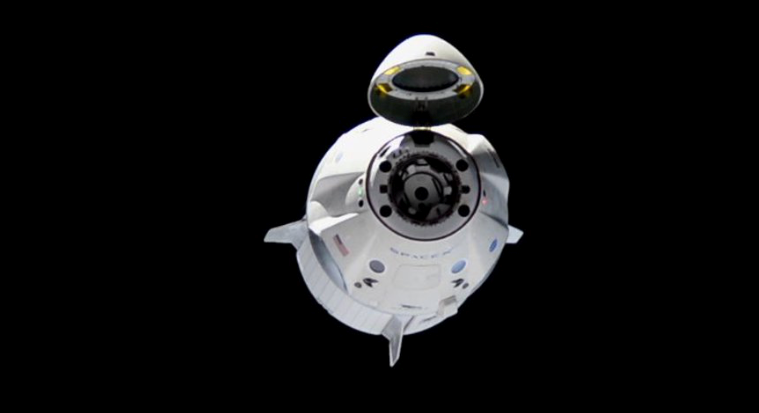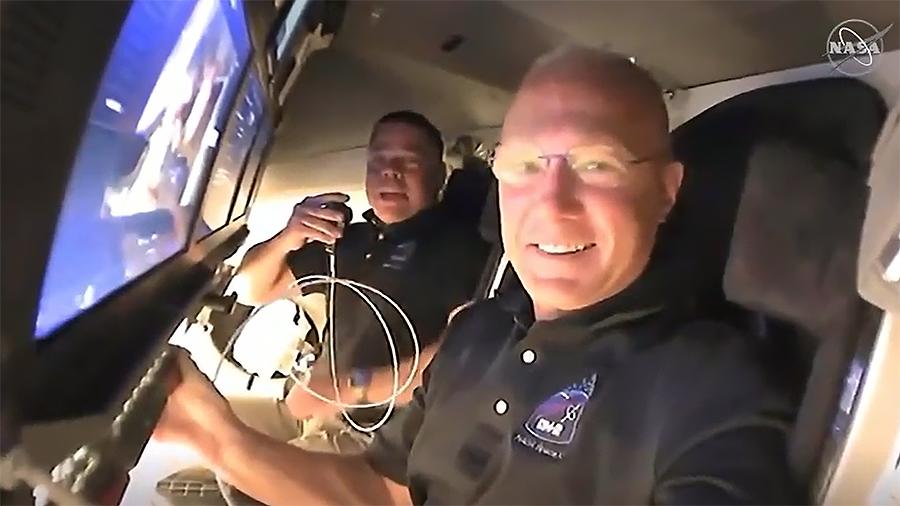
CAPE CANAVERAL—The first SpaceX Crew Dragon capsule to carry astronauts conducted a flawless approach and docking at the International Space Station (ISS) May 31, completing a 19-hr. journey as part of a key demonstration mission in advance of commercial flight services.
Pausing 722 ft. (220 m) in front of the ISS, veteran astronauts Douglas Hurley and Robert Behnken conducted a manual piloting test, using Dragon’s touchscreen controls to fire thrusters and move the vehicle left and right, up and down, forward and backward. It was the second and final demonstration of how a crew could dock the capsule manually in case its autonomous docking system fails.
“It flew very well, very crisp ... just about like the simulators,” Hurley radioed to flight controllers at SpaceX’s headquarters in Hawthorne, California.
(Click here and here for videos of the docking posted by NASA and SpaceX.)
So far, Crew Dragon’s Demonstration Mission-2 (Demo-2) flight test—the first with astronauts aboard—has gone extremely smoothly, according to SpaceX and NASA, which are conducting the mission jointly.
Hurley and Behnken lifted off aboard a SpaceX Falcon 9 rocket at 3:22 p.m. EDT May 30, marking the first time a private company has launched people into orbit and the first launch of astronauts from the U.S. since the space shuttles were retired in 2011.
In an homage to one of those retired shuttles, Hurley and Behnken named their Crew Dragon capsule Endeavour.
Hurley and Behnken, both test pilots and veterans of two shuttle missions, began their first full day in orbit with a 4:45 a.m. EDT wakeup call from SpaceX, which revived the tradition of using music to rouse the crew. For Hurley and Behnken it was “Planet Caravan” by Black Sabbath.
“We had a great night last night, got to get a little sleep,” Hurley radioed to flight controllers.

After reaching orbit, Dragon Endeavour conducted five phasing burns to synchronize its flight path with the station’s, then began a slow approach, first from behind and then from directly in front of the orbital outpost.
After Hurley and Behnken’s manual flight test, the capsule’s autopilot resumed control, driving it into the station’s Node 2 Harmony forward docking port at 10:16 a.m. EDT as the station sailed 262 mi. over the northern border of China and Mongolia.
“It’s been a real honor to be just a small part of this nine-year endeavor since the last time a United States spaceship has docked with the International Space Station,” Hurley said. “We have to congratulate the men and women at SpaceX ... Their incredible efforts over the last several years to make this possible cannot go overstated.”
Over the next two hours, Dragon Endeavour was integrated into the space station’s power, environmental control and communications systems, and Hurley and Behnken transferred into the ongoing Expedition 63 crew.
“We’re all super excited to have two more crewmates to the Expedition 63 team,” ISS Commander Christopher Cassidy said during a welcoming ceremony. “Maybe we’ll get outside to do some spacewalks.”
Cassidy is overseeing the station with half of the usual six-member resident crew—the result of U.S.-purchased rides on Russia’s Soyuz spacecraft coming to an end. Pending the results of Demo-2, it will be up to SpaceX to pick up crew ferry flights, possibly as early as Aug. 30, and return the station to full staffing.
“We have had a tremendous partnership with [Russian space agency] Roscosmos and we will continue to do so, but it is nice to see crew arrive from this side of the space station after nine years,” Johnson Space Center director Mark Geyer told the joint crew.
In addition to Cassidy and the Dragon Endeavour astronauts, the Expedition 63 crew includes Russian cosmonauts Anatoly Ivanishin and Ivan Vagner.
NASA’s other Commercial Crew provider, Boeing, intends to perform the first crewed flight with its CST-100 Starliner capsule next year.





